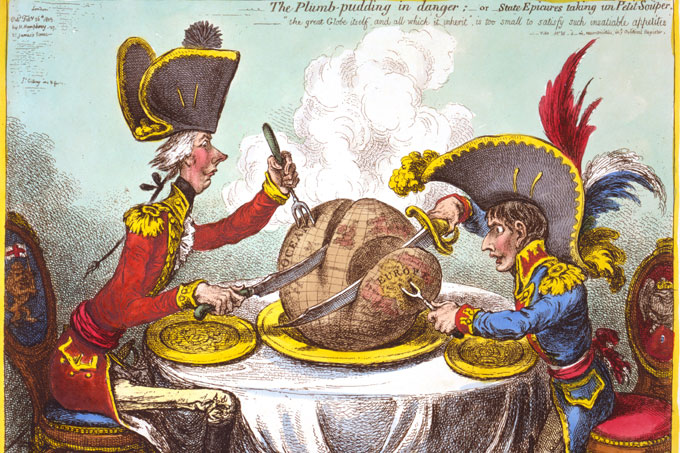Peter Vujakovic, Professor of Geography in the School of Human and Life Sciences, explores the use of caricatures in media publications during the festive season.
T’is the season to be jolly! This December many news magazines have decked their covers with humorous caricatures and satirical graphics. The New Statesman has Donald Trump and Theresa May ski jumping …over the cliff edge? The Week has Boris Johnson in the ‘dog-house’. Even Time Magazine’s ‘Person of the Year’ cover seems to have been strategically arranged so the title letter ‘M’ provides a devilish touch to Trump’s profile. Time denies intent and notes that given the letter’s “location on the cover, many other subjects in the past have also appeared to sprout extra features. It’s happened to Hillary Clinton at least twice.”
What is clear, however, is the stinging intent in celebrated cartoonist Peter Brookes’ cover image for the Spectator. This features Trump and Putin literally carving-up the globe (in the form of a pudding), with Putin serving himself a large slice of the ‘Middle East’. Brookes’ cartoon is a direct pastiche of one of the most famous political graphics in history, James Gillray’s 1805 ‘The Plum Pudding in Danger’, in which the original protagonists were Pitt and Napoleon. This cartoon has been recycled many times; including Thatcher and Foot, Bush and Gorbachev, and recently Cameron and Sturgeon. Like an element of any great festive pantomime it’s an old joke with a contemporary twist. The globe or map in cartoons has always been subject to the power of the protagonists; to control, ‘cleansing’, fragmentation, or even destruction. Numerous examples abound, from Lenin sweeping the globe clear of capitalists, clergy and kings, to Putin ripping a map of Ukraine apart. But are these images under threat?
As Will Self has noted satire must ‘comfort the afflicted and afflict the comfortable’, and Brookes’ work does this. There is, however, a danger that true satire might be endangered by two contemporary processes, first a ‘scatter-gun’ approach in which, as Self has pointed out, the ‘afflicted’ have been made uncomfortable by some of the images produced by cartoonists; he cites cartoons of Mohammed. And secondly, the growing problem of ‘self-censorship’; a reaction to the threats of both violent extremists and the litigious tendencies of the rich and powerful. In the same month as Brookes’ cartoon, US artist Alison Jackson, who has recently published photographs with Trump ‘look-a-likes’, has claimed that she has to fight hard against ‘self-censorship’. “It makes you frightened, it makes you put the brakes on and that is very worrying.” She goes on to note, “Whether it’s artists or cartoonists or satirists, there has to be free and radical thinking. Without that we get into the realms of dictatorship.”
 Expert comment
Expert comment holly finch
holly finch 2907
2907


